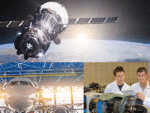Atmos Space Cargo has recently achieved a major milestone in the space domain.
The launch of their Phoenix vehicle marks a significant advancement in reentry technology.
This bold mission reveals the potential of inflatable thermal shields.
The first flight of Phoenix successfully took place despite limited data on its performance during reentry. In April, the vehicle separated from the upper stage about 90 minutes after liftoff during SpaceX’s Bandwagon-3 ride-share mission. The reentry led to a splashdown in the South Atlantic, nearly 2,000 kilometers off the Brazilian coast. The main objectives of the mission included collecting in-flight data, operating and returning data from the payloads, as well as evaluating the inflatable thermal shield of Phoenix. Although the trajectory was altered, preventing vehicle recovery, valuable information was obtained. Feedback from commercial customers and the German aerospace agency DLR confirmed the successful operation of the payloads. This experience paves the way for the launch of the second Phoenix vehicle planned for next year, thereby enhancing the capabilities of Atmos Space Cargo in space exploration.

Table des matières
ToggleAtmos Space Cargo successfully launches the first test flight of Phoenix
The European space landscape welcomes a significant advancement with Atmos Space Cargo, a German startup that recently announced the success of its first test flight of Phoenix, a reentry spacecraft equipped with an inflatable thermal shield. This mission, though marked by some uncertainties during reentry, represents a crucial step in the development of reentry and space transport technologies.
What were the objectives of the Phoenix mission?
The Phoenix mission, launched on April 21 aboard SpaceX’s Bandwagon-3 ride-share mission, had several key objectives. According to Sebastian Klaus, CEO of Atmos Space Cargo, the main goals were to gather in-flight data directly from the spacecraft, operate and recover data from the onboard payloads, and finally, assess the performance of the inflatable thermal shield during the atmospheric reentry. These objectives aim to demonstrate the viability of Atmos’s reentry technology and lay the groundwork for future commercial missions.
The four payloads onboard Phoenix, from commercial customers and the German aerospace agency DLR, were all successfully activated and returned critical data. “We can call this a total success,” Klaus said during the April 22 briefing. This initial success not only validated Atmos’s ability to integrate and manage various payloads, but also demonstrated the robustness of Phoenix’s communication and data recovery systems.
How did the trajectory change impact reentry?
Initially, Phoenix’s reentry was planned for the Indian Ocean, east of Madagascar, near Reunion Island. This location had been carefully planned, including the deployment of ships to recover the vehicle after splashdown and the use of aircraft to collect data during reentry. However, five weeks before the launch, SpaceX informed Atmos of a necessary trajectory change due to “operational constraints” related to the primary launch of a South Korean reconnaissance satellite.
This change had notable repercussions, shifting the planned splashdown to more than 2,000 kilometers off the Brazilian coast in the South Atlantic. This new trajectory involved a steeper atmospheric reentry, increasing the stresses on the vehicle and making the recovery of Phoenix impossible after splashdown. Teams had to react quickly, setting up new ground stations in South America and chartering a plane to attempt data collection, although the distance and cloud cover limited their effectiveness.
What data was collected during the flight?
Despite the challenges encountered during reentry, Atmos Space Cargo successfully collected a significant amount of useful data. Klaus indicated that the flight data collected was abundant, allowing for a thorough analysis of the vehicle’s performance. While some data regarding the inflatable thermal shield during the final phase of reentry is still to be analyzed, initial indications show that the shield inflated correctly as expected.
The inflatable thermal shield represents a major innovation for reentry vehicles, offering a lightweight and adaptable alternative to traditional systems. The data collected will not only optimize Phoenix’s performance but also improve future designs for more demanding missions. Additionally, the recovery of data from the payloads demonstrated Atmos’s ability to manage complex missions with varied equipment.
The resilience of Atmos in the face of unforeseen events
Atmos’s ability to quickly adapt to trajectory changes and logistical challenges was a determining factor in the partial success of the mission. Despite the constraints imposed by SpaceX, the company was able to implement alternative solutions to minimize the impact on the collection of essential data.
What are the implications for the future of Atmos Space Cargo?
The success of the first test flight of Phoenix, despite the uncertainties encountered during reentry, opens new perspectives for Atmos Space Cargo. The company is already planning to launch a second Phoenix vehicle next year, using feedback from this first mission to refine and enhance its technologies. “It would be much better to have more data on the critical phase of the last stage of flight,” Klaus stated, emphasizing the importance of ongoing analyses to perfect the system.
Atmos Space Cargo aims to become a major player in commercial space transport, offering innovative and reliable reentry solutions. The experience garnered from this pilot mission is invaluable for the development of upcoming initiatives, whether for payload return missions, satellite delivery services, or other space applications. Furthermore, collaboration with commercial partners and space agencies strengthens Atmos’s position in the industry and opens the door to future collaborations.
How is Atmos Space Cargo positioning itself in the space industry?
By integrating advanced technologies such as the inflatable thermal shield on Phoenix, Atmos Space Cargo stands out in the rapidly growing space sector. This innovation not only reduces the weight of reentry vehicles but also offers increased flexibility in reentry missions. This ability to innovate quickly and efficiently is essential to remain competitive against other market players.
Atmos Space Cargo also benefits from a favorable ecosystem in Germany and Europe, with initiatives such as Texas granting subsidies to five space companies, which support the development and innovation in the space sector. These financial and logistical supports allow Atmos to continue investing in research and development, thereby accelerating technological progress.
What challenges remain for Atmos Space Cargo?
Despite initial successes, Atmos Space Cargo still faces several challenges to solidify its market position. One of the main challenges is improving data recovery during critical phases of flight. The increased distance and unpredictable weather conditions limited the quantity and quality of the information gathered, making it more challenging to conduct a comprehensive assessment of the thermal shield’s performance.
To overcome these obstacles, Atmos plans to expand its network of ground stations and collaborate with international partners for better tracking of vehicles during reentries. Additionally, improving communication and data recovery technologies is crucial for obtaining more detailed and accurate information during future missions.
The importance of continuous innovation
Continuous innovation is essential for maintaining Atmos Space Cargo’s competitive advantage. By investing in new technologies and collaborating with industry experts, the company can develop even more efficient and reliable solutions for space transport.
What are the upcoming projects of Atmos Space Cargo?
Looking to the future, Atmos Space Cargo plans to launch a second Phoenix vehicle next year, with improvements based on the lessons learned from the first test flight. This new mission aims to test enhanced iterations of the inflatable thermal shield and increase the vehicle’s reentry capacity. Furthermore, the company is exploring partnerships with other players in the space industry to expand its service portfolio and meet a broader range of customer needs.
Atmos Space Cargo is also considering extending its operations beyond reentry missions, exploring opportunities in satellites, space transport services, and even research and development missions in collaboration with academic and scientific institutions. These initiatives aim to position the company as an innovative leader in the global space sector.
To learn more about inspiring journeys in the space field, check out articles like How Neil Armstrong Became the First Man to Set Foot on the Moon or discover the achievements of Oleg Artemyev, the Russian astronaut who commanded the space station.
What is the impact of this mission on the European space industry?
The partial success of the Phoenix mission from Atmos Space Cargo has positive repercussions for the entire space industry in Europe. By demonstrating the feasibility of innovative technologies such as inflatable thermal shields, Atmos contributes to strengthening Europe’s position on the global space stage. This technological advancement opens the door to new applications and collaborations, thus stimulating growth and innovation in the sector.
Moreover, this mission highlights the importance of institutional support and grants, such as those awarded by Texas to five space companies, which are essential for enabling startups like Atmos to develop and test their technologies. For more information on initiatives supporting space companies, visit this article.
How does Atmos Space Cargo manage logistical challenges?
The logistical challenges encountered during the Phoenix mission underscored the importance of rigorous planning and rapid adaptability. Atmos Space Cargo had to readjust its plans due to the trajectory change imposed by SpaceX, demonstrating its flexibility and resilience. The establishment of new communication stations in South America and the attempt to charter a plane for data collection are examples of this adaptability.
To improve its future logistical management, Atmos plans to diversify its communication networks and install additional infrastructures in strategic locations. This will not only reduce data recovery times but also increase the accuracy and quantity of information collected during reentry missions.
What is the long-term vision of Atmos Space Cargo?
The long-term vision of Atmos Space Cargo is to become a key player in commercial space transport, offering innovative and reliable solutions for reentry and payload return. The company aspires to develop a fleet of Phoenix vehicles capable of meeting a variety of needs, ranging from the return of destroyed satellites to the secure transmission of sensitive data from space.
Moreover, Atmos Space Cargo aims to expand its operations by collaborating with technological and scientific partners, thus fostering innovation and knowledge exchange. This collaborative approach allows the company to stay at the forefront of technological advancements and respond effectively to market changes in the space sector.
























